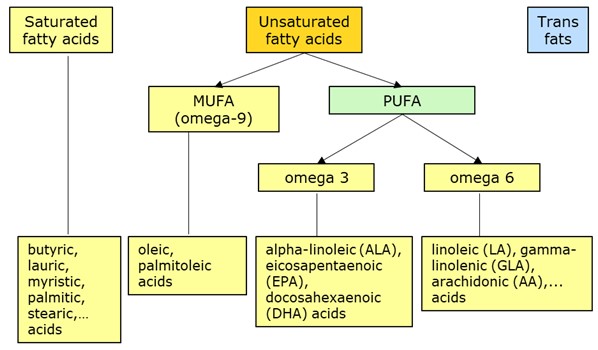Omega 3 and other fatty acids: what to eat?


Official fatty acid recommendations are quite funny, at least in Europe:
We should absorb around 30% of our daily energy intake in the form of fatty acids. Ok; knowing that there are about 9 kcal per g of fatty acid, it's possible to do a calculation.
But the recommendations don't stop there - and rightly so, since one fatty acid is not equivalent to another: we should absorb this 30% with a breakdown of around 50% monounsaturated fatty acids (MUFA), 25-30% polyunsaturated fatty acids (PUFA) and 20-25% saturated fatty acids (SFA). Finally, as far as PUFA are concerned, the ideal ratio of omega 6 to omega 3 is 5:1. Here, it's impossible or virtually impossible to make calculations. You'd need to know not only the lipid content of each food consumed, but also the nature of these lipids.
Fortunately, these quantities and proportions can be approximated by:
Cooking with olive oil.
Using an omega-3-rich oil, such as rapeseed oil, to season your meals.
Eating oily fish twice a week.
Regularly eating a handful of oilseeds, eggs, and avocados.
Reducing your consumption of red meat to no more than once a week.
Limiting cheese consumption.
Avoiding processed foods, chips, and fried foods.
Avoiding butter substitutes (it's better to eat real butter).
Personally, as I tend to have a low lipid intake, I go all out on olive oil and rapeseed oil, I don't restrict my egg consumption and I eat a few oilseeds every day. When I do this, my erythrocyte fatty acid balance shows that I'm on the right track. We tend to avoid fat when we're concerned about our weight, but this means depriving ourselves of cholesterol, which is necessary, and of membrane fluidity, particularly in neuronal membranes, with a possible impact on mood. So, it's not a good idea. If I had to ration myself, I'd rather avoid high-GI carbohydrates than fats.
A quick reminder of the different fatty acids and where to find them:
A. Saturated fatty acids have all their carbon atoms linked to a hydrogen atom. This makes them stronger, but less flexible. They are solid at room temperature. They are found in butter, cheese, meat, pastries, and industrial foods. A distinction is made between:
Short-chain SFA with fewer than six carbon atoms, such as butyric acid. They are good for the body, as long as you don't exceed the ideal quantities.
Medium-chain SFA with six to ten carbon atoms. They are also generally good for the body.
Long-chain SFA with more than ten carbon atoms, such as myristic and palmitic acids. They are harmful to the body, in particular by causing intestinal inflammation. As its name suggests, palmitic acid is found in palm oil, for example.
B. Unsaturated fatty acids have at least two carbon atoms not linked to a hydrogen atom. They are less resistant but more flexible and are liquid at room temperature. A distinction is made between:
Monounsaturated fatty acids (MUFA), which have only two carbon atoms that are not linked to a hydrogen atom. This is the omega 9 family, with oleic acid and palmitoleic acid. They are found in avocados, oilseeds, and vegetable oils (e.g., hazelnut oil 80%, olive oil 75%, rapeseed oil 62%, camelina oil 30%, sunflower oil 27%).
Polyunsaturated fatty acids (PUFA), which have at least four carbon atoms not linked to a hydrogen atom:
Omega 6 PUFA have their first double bond on the 6th carbon atom of their chain, counting from right to left, hence their name. They include linoleic acid (LA), gamma-linolenic acid (GLA) and arachidonic acid (AA). They are found in seeds, oilseeds, and vegetable oils (e.g., sunflower oil 64%, hemp oil 59%, walnut oil 55%, camelina oil 28%, rapeseed oil 20%).
Omega 3 PUFA have their first double bond on the 3rd carbon atom of their chain, counting from right to left. They are alpha-linolenic acid (ALA), eicosapentaenoic acid (EPA) and docosahexaenoic acid (DHA). ALA is found in seeds, oilseeds, and vegetable oils (e.g., flaxseed oil 56%, camelina oil 33%, hempseed oil 19%, walnut oil 15%, rapeseed oil 10%), as well as in green vegetables. EPA and DHA are found mainly in cold-water fish (tuna, salmon, sardines, mackerel, herring).
C. Trans-fatty acids (trans fats) are produced either by intestinal bacteria in ruminants, or by the partial hydrogenation (addition of hydrogen atoms) of unsaturated fatty acids to give them a smoother texture. They are deleterious and increase the risk of cardiovascular disease. They are found mainly in margarines, industrial dishes, pastries, chocolate bars and industrial cookies.
Very important: oils should be stored in dark glass bottles to limit their oxidation by light. Oils rich in polyunsaturated fatty acids, such as rapeseed, linseed, hemp or camelina oil, should also be kept refrigerated to prevent rapid oxidation at room temperature.
To find out more, also read these articles:
About cholesterol and the nutritional value of eggs: https://isabellemaesnutrition.com/en/cholesterol
